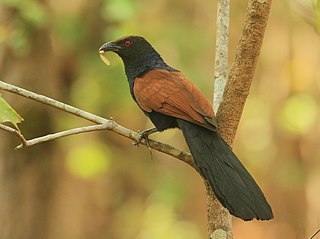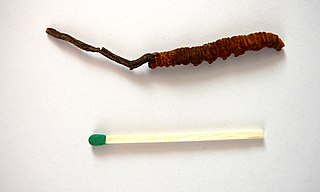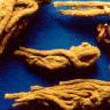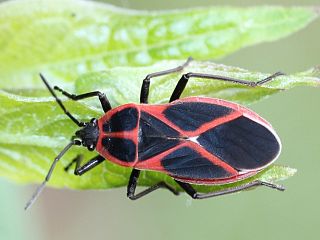
Citrus is a genus of flowering trees and shrubs in the rue family, Rutaceae. Plants in the genus produce citrus fruits, including important crops such as oranges, lemons, grapefruits, pomelos, and limes. The genus Citrus is native to South Asia, East Asia, Southeast Asia, Melanesia, and Australia. Various citrus species have been used and domesticated by indigenous cultures in these areas since ancient times. From there its cultivation spread into Micronesia and Polynesia by the Austronesian expansion ; and to the Middle East and the Mediterranean via the incense trade route, and onwards to Europe.

Hibiscus rosa-sinensis, known colloquially as Chinese hibiscus, China rose, Hawaiian hibiscus, rose mallow and shoeblack plant, is a species of tropical hibiscus, a flowering plant in the Hibisceae tribe of the family Malvaceae. It is widely cultivated in tropical and subtropical regions, but is not known in the wild, so that its native distribution is uncertain. An origin in some part of tropical Asia is likely. It is widely grown as an ornamental plant in the tropics and subtropics.

The greater coucal or crow pheasant, is a large non-parasitic member of the cuckoo order of birds, the Cuculiformes. A widespread resident in the Indian Subcontinent and Southeast Asia, it is divided into several subspecies, some being treated as full species. They are large, crow-like with a long tail and coppery brown wings and found in a wide range of habitats from jungle to cultivation and urban gardens. They are weak fliers, and are often seen clambering about in vegetation or walking on the ground as they forage for insects, eggs and nestlings of other birds. They have a familiar deep resonant call which is associated with omens in many parts of its range.

Ophiocordyceps sinensis is known in English colloquially as caterpillar fungus, or by its more prominent names yartsa gunbu, or dōng chóng xià cǎo or Yarsa-gumba or Yarcha-gumba, or Keeda Jadi, or ရှီးပတီး. It is an entomopathogenic fungus in the family Ophiocordycipitaceae. It is mainly found in the meadows above 3,500 meters on Tibetan Plateau in Southwest China and Himalayan regions of Bhutan and Nepal. It parasitizes larvae of ghost moths and produces a fruiting body which used to be valued as a herbal remedy and in traditional Chinese medicine. Caterpillar fungus contains the compound Cordycepin, an adenosine derivative. However, the fruiting bodies harvested in nature usually contain high amounts of arsenic and other heavy metals so they are potentially toxic and sales have been strictly regulated by the CFDA since 2016.

The Chinese mantis is a species of mantis native to Asia and the nearby islands. In 1896 this species was accidentally introduced by a nurseryperson at Mt. Airy near Philadelphia, United States. Tenodera sinensis often is erroneously referred to as Tenodera aridifolia sinensis because it was at first described as a subspecies of Tenodera aridifolia, but Tenodera sinensis is now established as a full species.

Camellia sinensis is a species of evergreen shrubs or small trees in the flowering plant family Theaceae whose leaves and leaf buds are used to produce tea. Common names include "tea plant", "tea shrub", and "tea tree".

The Chinese mitten crab, also known as the Shanghai hairy crab, is a medium-sized burrowing crab that is named for its furry claws, which resemble mittens. It is native to rivers, estuaries and other coastal habitats of East Asia from Korea in the north to Fujian, China in the south. It has also been introduced to Europe and North America, where it is considered an invasive species. The species features on the list of invasive alien species of Union concern. This means that import of the species and trade in the species is forbidden in the whole of the European Union.

Angelica sinensis, commonly known as dong quai or female ginseng, is a herb belonging to the family Apiaceae, indigenous to China. Angelica sinensis grows in cool high altitude mountains in China, Japan, and Korea. The yellowish brown root of the plant is harvested in the fall and is a well-known Chinese medicine which has been used for thousands of years.

Eosimias is a genus of early primates, first discovered and identified in 1999 from fossils collected in the Shanghuang fissure-fillings of Liyang, the southern city of Jiangsu Province, China. It is a part of the family Eosimiidae, and includes three known species: Eosimias sinensis, Eosimias centennicus, and Eosimias dawsonae. It provides us with a glimpse of a primate skeleton similar to that of the common ancestor of the Haplorhini. The name Eosimias is designed to mean "dawn monkey", from Greek eos "dawn" and Latin simius "monkey".

The Chinese softshell turtle is a species of softshell turtle that is endemic to China, with records of escapees—some of which have established introduced populations—in a wide range of other Asian countries, as well as Spain, Brazil and Hawaii.

Miscanthus sinensis, the eulalia or Chinese silver grass, is a species of flowering plant in the grass family Poaceae, native to eastern Asia throughout most of China, Japan, Taiwan and Korea.

The South China catshark is a catshark of the family Scyliorhinidae, known only from the holotype, which was taken from the South China Sea at a depth of 537 m. Its length is 42 cm, but this measurement was taken from an immature specimen. The reproduction of the South China catshark is oviparous.

The Asian parti-colored bat is a species of parti-coloured bat. An adult Asian parti-colored bat has a body length of 6–7 cm, a tail of 4.3-4.5 cm, and a wing length of 5 cm. Asian parti-colored bats are distributed across East Asia, from Taiwan through eastern China, eastern Mongolia and Russia (Siberia) to the Korean Peninsula and Japan.

The white-shouldered starling is a species of starling in the family Sturnidae. It breeds in southern China and northern Vietnam; it winters in Southeast Asia.

The Chinese stripe-necked turtle or golden thread turtle, is a species of turtle in the family Geoemydidae.

The shrew gymnure, or shrew hedgehog, is a species of mammal in the family Erinaceidae and is the only extant species in the genus Neotetracus. It is found in China, Myanmar, and Vietnam.

Camellia taliensis is a species of evergreen shrub or small tree whose leaves and leaf buds are used to produce tea.

Silutitan is a genus of euhelopodid sauropod dinosaur from the Shengjinkou Formation of Xinjiang, China. It contains only the type species, Silutitan sinensis.

Tropidothorax cruciger is a species of seed bug in the family Lygaeidae found in Asia.



















